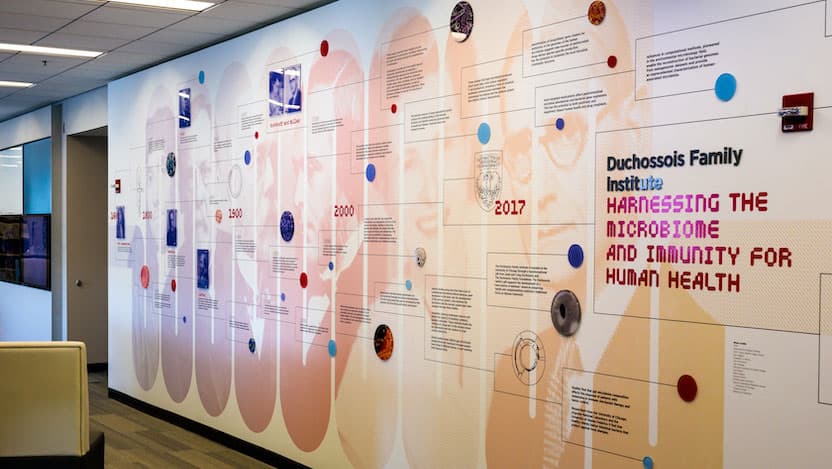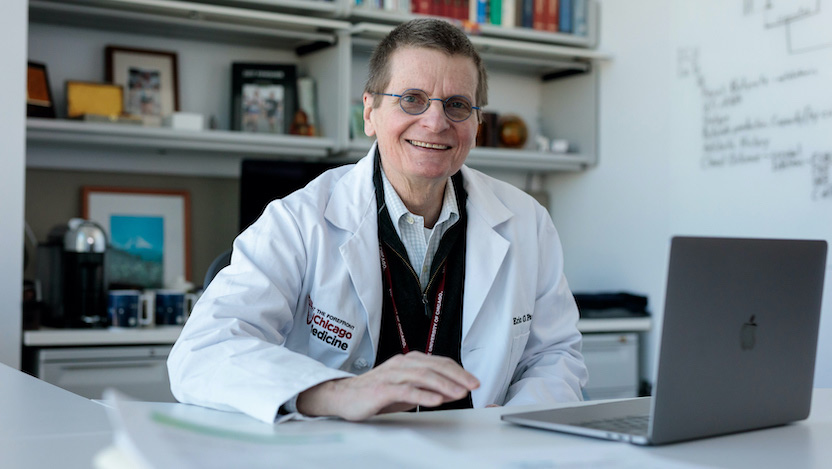Maximizing health and wellness through microbiome research

In Bangladesh, more than a third of children under 5 years old suffer from chronic malnutrition. The condition not only stunts growth — it ravages the microbiome, the collection of trillions of bacteria, viruses and fungi that live and thrive in our digestive tracts.
Because the microbiome affects so many systems within the body — everything from the immune system to mental health — Bangladeshi children need more than food to cure their malnutrition. They need the right kind of food to restore their microbiome health.
Several years ago, Duchossois Family Institute: Harnessing the Microbiome and Immunity for Human Health (DFI). Founded with the broad goal of maximizing good health and the economic, social and personal benefits it delivers, the institute has focused on achieving wellness through the intersection of the microbiome, the immune system and genetics, under the direction of renowned physician-scientist Eric Pamer, MD.

The institute has approached the microbiome from several angles — through interdisciplinary research and clinical studies, using state-of-the-art technology — to not only understand its levers, but how scientists can engineer solutions that mimic nature to restore order within patients’ bodies
“In just a few short years, the DFI has crystallized a multidisciplinary focus on the role of the microbiome in biology and disease and its potential to maintain wellness,” said Kenneth S. Polonsky, MD, Dean of the Biological Sciences Division, led efforts to launch the institute, established through a $100 million gift from Janet and Craig Duchossois and The Duchossois Family Foundation in 2017.
“The prescience and generosity of this gift has enabled the recruitment of best-in-class scientists and engineers spanning multiple departments, schools and divisions of the University,” Gilliam said. “Founding director Eric Pamer brings a razor-sharp focus to the institute. He seeks to understand the essential components of a healthy microbiome and then use this information for the production of microbiome-derived therapeutics to enhance the quality of clinical care and promote wellness.”
In recent years, the University has become a leader in studying the microbiome, with collaborative, multidisciplinary projects underway in all areas of microbiome research and expertise in sequencing, imaging, research computing and core facilities. UChicago faculty have identified the role of the microbiome in improving effectiveness in cancer immunotherapy, the healthy development of preterm infants, and treating children with severe food allergies.
From infectious diseases to microbiome health
Understanding the microbiome is no small feat. Not only are there hundreds of species of bacteria in our guts, every person has their own signature network of pathogenic and symbiotic microbiota. This network can be disturbed by diet, antibiotics and illness, and the resulting imbalance affects not just gut health, but also the immune system, mental health and chronic diseases like atherosclerosis. Among scientists and physicians, the microbiome’s importance is increasingly hard to overstate. It’s often called the next frontier of health and even the “second brain” within our bodies.
For much of his career as chief of infectious diseases at Memorial Sloan Kettering Cancer Center, Pamer wasn’t focused on studying the microbiome, but he was interested in treating antibiotic-resistant pathogens that were common among cancer patients.
The University of Chicago has become a leader in studying the microbiome, with collaborative projects underway in all areas of microbiome research.
That’s when he and his collaborators began to sequence the bacteria in the gut and found that the loss of normal bacteria increased the risk of adverse effects in patients undergoing stem cell transplants. His interest began to shift to this powerful ecosystem within us, and when the Duchossois Family Institute was founded, he became its first director in 2019.
“I was excited to come to the University of Chicago to be able to investigate the impact of the microbiome in a wider range of patients and conditions,” he said. “I wanted to work with clinical research teams on the microbiome’s role in a variety of diseases, from vascular disease to Alzheimer’s disease to inflammatory bowel disease.”
Understanding metabolites
Since his arrival, Pamer has worked to recruit faculty members, hire staff and begin clinical studies with partners in surgery, cardiology, pathology and critical care medicine. At their disposal are the institute’s core facilities, which provide the critical resources needed to understand the microbiome and correlate it with clinical events. The metagenomics core takes clinical samples — stool samples from University of Chicago Medicine patients — extracts their DNA and prepares it for sequencing at UChicago’s Genomics Facility. That tells researchers which bacteria are present in each sample.
But perhaps more interesting are the data that come from the institute’s metabolomics core. The bacteria in the gut consume our food and then produce metabolites, small molecules in the form of chemicals, hormones and vitamins that are absorbed into our body.
“Over the past decade, we’ve learned that metabolites impact many areas of the body, including immune development, mental states and the liver’s response to alcohol,” Pamer said. For example, one such metabolite, butyrate, works to modulate proper immune system function.
But much work needs to be done to understand which metabolites correlate with which bacteria and how those bacteria correlate with clinical events. The metabolomics core uses mass spectrometry to test each sample for 200 different metabolites, a number that will increase as more metabolites are identified.
The core runs like a small business within the institute, working with professors and clinicians to expeditiously provide metabolite data, while providing additional context as to what the data mean.
Up and running for the past year, the core’s goal is to continue to expand its knowledge of metabolites and what metabolomics can tell us about our health.
Creating a capsule for bacterial reconstitution
Pamer has clinical studies running with groups in transplant surgery and critical care, where patient’s metabolites are analyzed and compared with their outcomes. The ultimate goal is to use the information gleaned from these studies to be able to take certain bacteria and reconstitute a patient’s microbiome after antibiotic treatment. To that end, the institute has also developed a bacterial strain bank, in which they’ve grown nearly 2,000 strains of bacteria from healthy donors.
“In the coming years, we would like to be able to use rapid testing to see which bacteria or metabolites a patient has lost, then give them a capsule that contains the right bacteria to re-establish a normal profile,” Pamer said.
Production of such a capsule will be enabled by a bacteria manufacturing facility. Planning for the facility is already underway, and Pamer hopes to begin construction within the next two years.
The microbiome as an ecosystem
To get to that point requires more research across disciplines. Working with Pamer is a group of faculty members who each approach understanding the microbiome from a unique angle.
Sam Light, PhD, is studying the microbiome as an ecosystem. Just like some animals and organisms thrive in a humid rainforest, while others thrive in an arid desert, some bacteria in the gut thrive in the stomach, while others thrive deep in the intestines. Not only that, this bacterial ecosystem has its own food chain — some bacteria eat the food we eat, while others eat the waste from bacteria.
“Our grand goal is to really understand where each microbe fits into that ecological framework,” said Light, an assistant professor of microbiology.

Light previously discovered that certain microbes residing in the gut respired by transferring electrons to their surroundings — something that scientists knew happened in nature, but did not know happened within our bodies as well. That got him interested in understanding the ecosystem.
Now, with the help of the DFI cores, his team is using fecal samples to see which microbes prevail under which conditions. They are also doing more targeted research. For example, they know that certain microbes respire cholesterol. Now they are trying to figure out which microbes do that, how they do it and why they do it.
“Developing this framework will help make it clearer what is happening within the microbiome, to identify the difference between a microbiome in a diseased state and in a healthy one,” he said. “It will also help lead to insights into how to make interventions to return a diseased state to a healthy state by replenishing certain microbes.”
Harnessing big data
Considering the microbiome contains a huge array of micro-organisms, developing such a framework might seem impossible. But for professors like Raman, “You cannot believe this is infinitely complex. If you do, you have to quit.”
Raman, too, is interested in deriving the instructional manual for biological systems — a so-called wiring diagram of how everything works together. Just as he did with the Bangladeshi children, he is approaching this problem by finding the right levers to push and pull.
To do this, he and his team are harnessing the tool of our times: data. They started with the well-studied bacteria E. coli and set out to find if they could create its “wiring diagram.” They downloaded 7,000 publicly available bacterial genomes and created a new mathematical framework to analyze them. That led to a statistical way of being able to show how all of the proteins give rise to that bacterial phenotype.
“If two proteins co-vary with each other, that means they likely interact,” he said. “It’s as simple as that, but we needed to analyze the data to show how this works. The post-genomic era has been a boon for people like us. It provides the ability to navigate complex systems in a really facile way.”
By combing faculty expertise in microbiology, chemistry, pathology and big data, faculty associated with the DFI hope to build a whole that is greater than its parts.
“We’re not all one person,” Raman said. “That is by design. We’re all meant to collectively work together. That way something clinically actionable can come out of what Eric [Pamer] is trying to build.”
Bringing innovations to the clinic
To support research and clinical studies, DFI has provided fellowship support for clinical fellows who are interested in research careers. The institute has started offering multidisciplinary grants to support collaborations between research scientists and clinical investigators, and is working with the University’s Polsky Center for Entrepreneurship and Innovation to ensure any breakthroughs can make it to market.
“We want to help build these bridges for investigators to take the first step toward transferring laboratory discoveries to the clinic,” Pamer said.
The Duchossois Family Institute was originally founded to support research not only in the microbiome, but also in genetics and immunology. Pamer said that these are a continuum — all three areas impact each other. “There is so much to be done,” he said. “The field has exploded and left us with so many opportunities to do research.”
